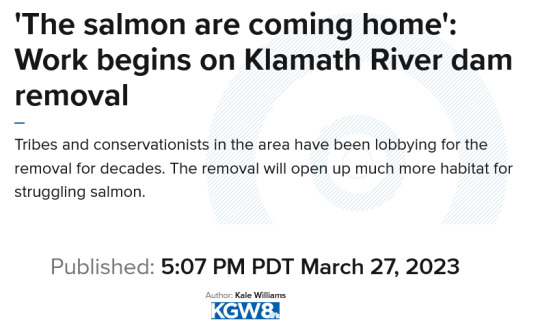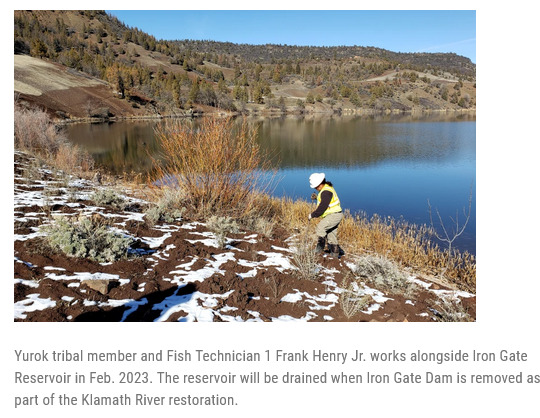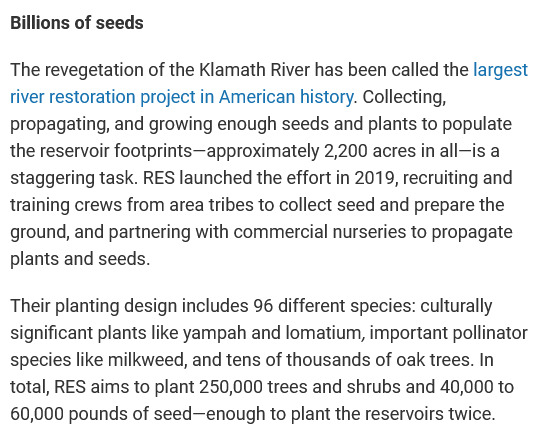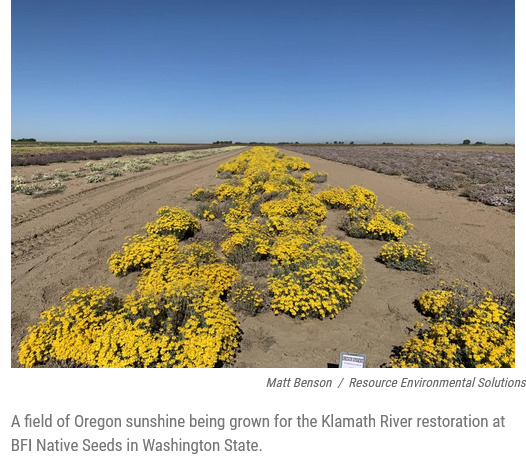#upland milkweed
Explore tagged Tumblr posts
Text

Headline by: Ryan Burns. “Ground Has Been Broken on Klamath River Restoration, the World’s Largest-Ever Dam-Removal Project.” Lost Coast Outpost. 23 March 2023.
---

The world’s largest dam removal in history is slated for 2023. Led by Indigenous tribes in partnership with organizations, lawyers, scientists and activists, the project will remove four dams, clearing the way for the lower Klamath River to flow freely for the first time in more than a century.
Headline and italicized text excerpt by: Malia Russ. “The Science of Saving Salmon as Klamath Dams Come Down.” UC Davis - Blogs - Climate. 24 February 2023.
---

Headline by: Jackson Guilfoil. “Klamath dam removals, habitat restoration, begins.” The Mercury News. 25 March 2023.
---

Headline by: Kale Williams. “‘The salmon are coming home’: Work begins on Klamath River dam removal.” KGW8. 27 March 2023.
---





Iron Gate is a sinuous, skinny reservoir tucked into the folds of the Siskiyou Mountains. Draining it will expose about 900 acres of wet mud. “It’s our job to make sure it’s revegetated. We want that to be revegetated with a healthy native plant ecosystem,” says Joshua Chenoweth, Senior Riparian Ecologist for the Yurok Tribe who is leading the replanting effort. [...] Last fall, they seeded the strip with a mix of native grasses and flowering plants; now, they’re installing young shrubs and trees: buckbrush, serviceberry, and Oregon ash, along with the Klamath plum. Collectively, these plants will create a “wall of green,” taking up space that would have otherwise been overrun by non-native plants [...]. The revegetation of the Klamath River has been called the largest river restoration project in American history. Collecting, propagating, and growing enough seeds and plants to populate the reservoir footprints -- approximately 2,200 acres in all -- is a staggering task. [...] Their planting design includes 96 different species: culturally significant plants like yampah and lomatium, important pollinator species like milkweed, and tens of thousands of oak trees. [...] What will a restored, wild Klamath River look like? Imagine it. Stand at the Wanaka Springs boat launch and picture Iron Gate reservoir drained. The river has found its channel at the base of its original canyon. Willows flank the banks. Much of the reservoir footprint is flush with upland vegetation -- oak copses; thickets of buckbrush and Klamath plum; blooming rose and lupine.
---
Headline, images, captions, screenshot, and italicized text excerpt from: Juliet Grable. “After the dams: Restoring the Klamath River will take billions of native seeds.” Jefferson Public Radio. 13 March 2023.
2K notes
·
View notes
Text

Plant Profile: Sassafras - S. albidum
This plant profile spotlights an American favorite, the originator of a flavor profile loved/hated throughout the world and perhaps one of the more unique eastern trees with a name that's very fun to say. Today we will discuss the Sassafras.

If you went to an American Public school near an eastern forest, you probably had a nature walk where someone pointed out Sassafras for its connection to root beer. For its smell alone I find it's a fun plant to teach people about, there's honestly nothing else around here quite like it.
Let's start with description, Sassafras is a member of the laurel family (think aromatic woods like Bays, Spicebush, and Avocados). The tree itself is easily distinguished by its scent/form/and unique leaf features. The bark when young is smooth and grey but as it ages it can become furrowed and reddish brown and the main trunk is almost always kinda wavy. The twigs are grey to yellow green when young and an easy access source to encounter the lovely rootbeer scent. Sassafras has 3 different types of leaves, one standard ovular pointed leaf, a 2-lobe, and a 3 lobed mitten like leaf (image above) the upper surface is hairless while the underside is hairy. The most distinguishing characteristic of Sassafras is its extremely vibrant and variable mix of fall coloring, often turning yellow, pinkish, orange, or red; sometimes all on different leaves, it's a bit unpredictable. The tree itself is unisexual meaning flowers are either male or female but the small fragrant yellow flowers form globular puffs along the branches (see images below). The fruit itself is a small blue thing attached to a reddish stem, I've never seen one up close usually the birds get them before me.


Range and habitat: Sassafras can be found in upland or sandy/rocky to loamy neutral soils throughout the eastern US, Southwest to East Texas, South East to like Jacksonville Florida, Northeast to Southern Maine then Sporadically West to Iowa. In these locations it primarily acts as an earlier succession species, requiring light to actually thrive, Sassafras is aggressive but can also exist comfortably in forests when mature.
Sassafras itself has a variety of behaviors influenced by condition/habitat. I most commonly find it along the Appalachian trail in oak heaths or forested mountain slopes where openings once were, here its usually found as a singular wavy reddish trunk among other tall trees (Image 1). But typically Sassafras is a pioneer species, saplings will die without full sun, because of this the tree is more likely to propagate along fencerows, old fields, and unmaintained disturbed ground. Here we can find nearly pure stands of dense wavy trunked colonies dominating open ground as one of the only species in a thicket. Sassafras also has an allelopathic affect on other plant life, this primarily affects the growth of annual herbaceous plants but also lowers the germination of other other seeds.
Mount Moriah Cemetery in Philadelphia is one of the most urban examples of this type of thicket (photo below by talented Philly Photographer Supernova)

All that being said about aggressive succession the tree has some pretty positive landscape value: bringing a pleasant odor, attracting birds, and lovely spring floral display (Sassafras in Philly park below). It's downside (aside from the possibility of numerous root clones... which doesn't always occur) is that the tree doesn't always transplant well, it will die if seemingly arbitrary conditions are not met, it just can't grow some places even with well draining soil and full sun.

Ecological value is very high with Sassafras, as a bird disturbed species it, of course, is an excellent energy source for summer birds and spring pollinators. The tree can also serve as an alternate host source for the Spicebush Swallowtail (image below of said butterfly on Swamp Milkweed)

Sassafras historically has had intense culture usage by anyone who comes in contact with it: Indigenous Americans, Europeans merchants, American Settlers, and Creole Cooks. I'll give a snippet of history and use of American Sassafras with each cultural relationship. I will warn everyone that according to the FDA: safrole (found in sassafras) has been found to cause cancers and serve liver damage in mice which is why natural Sassafras is no longer used in our rootbeers or deemed safe for human consumption. I will avoid supporting any 'medical claims' for Sassafras as an herbal supplements as that is extremely unethical, and will instead focus on the historical and wild food aspect.
Let's start with our First Nations, Sassafras is used in a variety of ways throughout Turtle Island both prior to colonization into today, most Indigenous relationships were medicinal in nature. My peer and I were directed to some uses when working with a Lenape clan last year. One can derive a red or yellow tea from Sassafras, Yellow is the easiest as you only require stems. Essentially you just take cleaned thick cuttings and boil them for half an hour till the tea is yellow. The red tea derives from root cuttings and has a stronger flavor, this was adapted by Colonists for other uses...
For the Europeans, early in the days of American Colonization, Sassafras was a beloved aromatic tree and medicinal herbs prioritized in trade with the indigenous groups. The Old World was concurrently suffering from syphilis outbreaks in the 1600s, which they assumed originated in the Americas. Europeans of the day marketed Sassafras Root as an -american- natural cure for the 'american disease' syphilis. With each grift there is a huge demand, some sources state Sassafras was the second most valuable wood in New England. This root elixir was considered a medicine (not helpful to curing Syphilis) to 1600s Europe and to this day is still mostly perceived that way by Europeans (for multiple reasons). The Asian species of Sassafras (Sassafras tzumu and S. randaienseare) also known in Chinese medicine however that's an entirely different history.
Later American Settler Traditions of making (slightly alcoholic) Root beer was a variation on Indigenous Root Tea recipes. I'm less familiar with that history but my professor used to make red root tea in southern Pennsylvania. The roots themselves have a gelatinous consistency which transfers into the tea and the beer, this is where the famous lasting foam comes from in Root Beer. Additionally, this quality is used southern cooking as Sassafras leave act as a thickening agent (in soups mostly).
Also aside from being carcinogenic apparently safrole (the reason sassafras is no longer consumed) is a List I chemical in the US (Highly tracked substance by the DEA) as it can be used to synthesize MDMA.... it's difficult to isolate so narcos of tumblr don't get too hopeful.

Lastly I'll focus on Propagation because it is a bit difficult but possible. The easier-to-gather but harder to succeed method is taking a root cutting from a colony in midwinter: you should find 1/4" thick pieces, wash them and cut them into 2" segments placed in seed-soil mixes horizontally and covered. For seeds (the more successful method but harder to find) remove the outer flesh as soon as they develop and place in moist blotting paper and stratify for 3-4 months, most are likely to germinate this way. You can also buy saplings from Bowmanhill Preserve in New Hope, PA; No shame in propagation failure...
This has been my piece on Sassafras, I hope you guys are more likely to spot the leaves and give them a smell next time you're outside. Please also heed the FDA's warning about the tea as a carcinogen, while I don't believe in denouncing indigenous food cultures, over consumption can harm you here. Happy Hunting.
3 notes
·
View notes
Note
so like its not a prompt and im the worst but for your consideration a sambucky aquarium date 🐠🦀🐡🐟🦈
Thank you so much for the prompt, @whothehellisbuckles 🥺 and lol you're not the worst, I have a Dealer's Choice section for a reason 😂 I hope you enjoy! 🥰
Date 12 of 28: Aquarium Date
| - 11 - | - Prompt - | - 13 - |
"You know you didn't have to take me and Eli to this, right?" asked Isaiah, walking with Sam through the Australia: Wild Extremes exhibit of the National Aquarium in Baltimore, hearing the Laughing Kookaburra in the distance, Sam watching a pig-nosed turtle wander past Sam in her exhibit.
"I know we didn't have to," said Sam, smiling softly as he glanced back to see Bucky with Eli, the both of them freaking out over the Swainson's Lorikeets, "But we wanted to."
When Bucky surprised Sam with a visit to Baltimore, Sam had been excited to see Eli and Isaiah again. Sam had meant to see them more frequently, but between missions and working with communities across the nation, Sam hadn't had a lot of time to visit Baltimore.
Bucky helping him make the time? Was priceless.
After asking Eli a few questions, Sam had surprised Isaiah with flowers and vegetables for his garden, smooth blue aster and cabbage and cinnamon fern and sage and butterfly milkweed and tomatoes and basil, taking the morning to add all the additions to Isaiah's garden.
And when Bucky suggested they go to the National Aquarium? Well, Sam wasn't swooning. He was just. Excited. Because aquariums were awesome.
Bucky even looked into the aquarium, got tickets in advance, researched what exhibits in the museum would have Sam's favorites, like the Peacock Mantis Shrimp, Emperor Angelfish, the Scarlet Ibis, Linne's Two-Toed Sloth, Lion's Main Jelly, White-Blotched River Stingray, and Humphead Wrasse, pointing them out excitedly, and Sam couldn't help but smile at how animated Bucky got about all the animals Sam loved.
"Well, thank you for letting us come, then," said Isaiah, "This whole visit... it's good to see you again."
Sam grinned.
"I'll always come to visit," said Sam, "Honestly, I should more often. I promise I'll try better. And you two can always visit us in Delacroix."
"I'll keep that in mind," said Isaiah, "Eli's been talking about looking at colleges outside of Maryland. Maybe he can see some in Louisiana. If he was going to leave Maryland, I'd rather him be near you than no one."
Sam paused and... took a moment. To not totally blubber all over Isaiah.
"Thank you," said Sam, "I... I understand that it's hard for you to trust people and I won't let you down if he chooses to go to a college near me."
"You're a good kid, Sam," said Isaiah, shrugging, "Weird taste in men, but I'm not here to tell you who to date."
"I know," said Sam, looking back again to see Bucky imitating the Johnston's Crocodile, Sam doing his best not to laugh at it, Bucky locking eyes with Sam as he started exaggerating his movements further, "But he's my weirdo."
Sam hung back, Eli moving past Sam to walk with his grandfather.
"Hey, weirdo," said Sam, putting his arm around Bucky's shoulder.
Bucky scowled adorably.
"Ugh. I'm not a weirdo," said Bucky, "I'm a loving and caring boyfriend."
"I know you are," said Sam, giving Bucky a kiss on the cheek, "Thank you for all of this."
"No, thank you for being a part of my life," said Bucky, wrapping his arm around Sam's waist, "Want to go to the Upland Tropical Rainforest exhibit? I heard they have a Golden Lion Tamarin and a Blue-Crowned Motmot. They also have that sloth you like and the Scarlet Ibis."
"I'd love to," said Sam, the two of them giving Eli and Isaiah some time alone, heading to the Upland Tropical Rainforest exhibit together.
❤️ ❤️ ❤️
Want to choose a date for Sam and Bucky to go on during this special February Daily SamBucky Fluff Diary event? Check out the prompts here and send me an ask! I’ll write you a drabble as one of my Daily SamBucky Fluff Diaries!
#thank you so much for the prompt bee 🥺#sambucky#the daily sambucky fluff diary#sambucky drabble#28 short sambucky dates#date 12#aquarium date#sam wilson#bucky barnes#isaiah bradley#eli bradley#they all have a very fun afternoon at the aquarium#then go back home so that sam and bucky can cook eli and isaiah dinner#only for eli and isaiah to help them with dinner in the end#it's just a really nice visit#my drabbles#my headcanons
43 notes
·
View notes
Photo



Pineneedle milkweed (Asclepias linaria). This is a native upland milkweed species. The flower umbels and ripe seed pods on this plant were small, only about 2.5 cm (1 inch) long. In Cochise County, Arizona.
188 notes
·
View notes
Text
While that’s just horrible, you, you…
*pulls out wildflower identification booklet*
You tansy ragwort. You nodding onion! You absolute tufted vetch! You’re just a no-good pinesap, a terrible blue stickseed! I bet your own family hates you, you good-for-nothing gumweed! You hear that? You’re just a common snowberry! I never should have spoken to you, the one-sided wintergreen you are! You hedge-nettle, the absolute nerve of you!
You long-bracted frog orchid, you spotted coralroot, you mountain ladysipper, you twayblade, you sulphur buckwheat, you tufted loosestrife, you upland larkspur, you shrubby cinquefoil, the worst baneberry of them all! You haunt my dreams with your hawthorn ways, you partridge foot! Don’t be a bitter cherry. Stop being a bald hip rose. Your red-stemmed saxifrage, chickweed monkey-flower, great mullein behind needs to be kicked right out of here! You’re such a showy milkweed, bunchberry! I never want to see your green false hellebore face ever again! So leave me alone, you trumpet honeysuckle!
7 notes
·
View notes
Text
Usage of Butterfly Education to Promote Plant Species and Proper Ecological Practices
As many of y’all know the tail of the preservation of the monarch butterfly also meant the return of Asclepias spp. to Nurseries and Magazines within’ their range. This did eliminate other problems tied into similar insect decline too; but, it did not hammer in the point to promote land ethics and host plant relationships enough to really get the ball rolling. If you are an out door educator, it is really easy to promote butterflies to children and with that, the native host plants they are associated with.

^ this is a Karner Blue Butterfly

^ and this pine and oak upland savannah with Ericacean soils is home to their host plant, the blue stuff, Lupinus perennis.

These plants and the ecological practices that come with managing this environment are crucial to the preservation of these species along with many others. The Karner Blue is endangered in much of it’s historic range with extreme disjunction events forming pocket populations that will eventually fade to nothing unless some sort of land ethic is picked up to promote their host plants.
(Photographs above from Mike Adamovic at Albany Pine Bush Preserve, NY. )
Just like many classic prairies, these types of savannas are preserved by prescribed burns to promote herbaceous species, acidity, and to mitigate woodies.
As outdoor educators, science explainers, and naturalists it is extremely important to communicate that these practices are crucial for land management to adults while also promoting these insects and their host plants to children if you care about ecosystem stability in the long run.
It’s also really fun when you can throw Paw Paw, Lilies, Spicebush, and Sassafras into the mix as much as possible.
Pipevine and Golden Alexanders would be great too.
The reason why im ranting about this is because of the lack of these plants floating around is extremely alarming when I can walk into a dollar store and easily find common milkweed on the shelves, these other plants have the potential to be promoted just as much, and it’s frustrating they’re not.
also check out this sweet @smartereveryday video.
youtube
#rants#ecology#entomology#botany#wildflowers#plantblr#insects#plants#flowers#horticulture#naturalists#nature blogs
256 notes
·
View notes
Photo










Iowa Wetlands (No. 2)
Iowa is bordered by the Mississippi River on the east and the Missouri River and the Big Sioux River on the west. The northern boundary is a line along 43 degrees, 30 minutes north latitude. The southern border is the Des Moines River and a not-quite-straight line along approximately 40 degrees 35 minutes north, as decided by the U.S. Supreme Court in Missouri v. Iowa (1849) after a standoff between Missouri and Iowa known as the Honey War.
Iowa is the only state whose east and west borders are formed entirely by rivers.
Iowa has 99 counties, but 100 county seats because Lee County has two. The state capital, Des Moines, is in Polk County.
Iowa's bedrock geology generally increases in age from west to east. In northwest Iowa, Cretaceous bedrock can be 74 million years old; in eastern Iowa Cambrian bedrock dates to c. 500 million years ago.
Iowa is generally not flat; most of the state consists of rolling hills. Iowa can be divided into eight landforms based on glaciation, soils, topography, and river drainage. Loess hills lie along the western border of the state, some of which are several hundred feet thick. Northeast Iowa along the Upper Mississippi River is part of the Driftless Area, consisting of steep hills and valleys which appear almost mountainous.
Several natural lakes exist, most notably Spirit Lake, West Okoboji Lake, and East Okoboji Lake in northwest Iowa (see Iowa Great Lakes). To the east lies Clear Lake. Man-made lakes include Lake Odessa, Saylorville Lake, Lake Red Rock, Coralville Lake, Lake MacBride, and Rathbun Lake. The state's northwest area has many remnants of the once common wetlands, such as Barringer Slough.
Iowa's natural vegetation is tallgrass prairie and savanna in upland areas, with dense forest and wetlands in flood plains and protected river valleys, and pothole wetlands in northern prairie areas. Most of Iowa is used for agriculture; crops cover 60% of the state, grasslands (mostly pasture and hay with some prairie and wetland) cover 30%, and forests cover 7%; urban areas and water cover another 1% each.
The southern part of Iowa is categorised as the Central forest-grasslands transition ecoregion. The Northern, drier part of Iowa is categorised as the Central tall grasslands and is thus considered to be part of the Great Plains.
There is a dearth of natural areas in Iowa; less than 1% of the tallgrass prairie that once covered most of Iowa remains intact; only about 5% of the state's prairie pothole wetlands remain, and most of the original forest has been lost. As of 2005 Iowa ranked 49th of U.S. states in public land holdings.Threatened or endangered animals in Iowa include the interior least tern, piping plover, Indiana bat, pallid sturgeon, the Iowa Pleistocene land snail, Higgins' eye pearly mussel, and the Topeka shiner. Endangered or threatened plants include western prairie fringed orchid, eastern prairie fringed orchid, Mead's milkweed, prairie bush clover, and northern wild monkshood.
There is little proof to suggest that the explosion in the number of high-density livestock facilities in Iowa has led to increased rural water contamination and a decline in air quality. In fact, covered manure storage in modern barns prevent that manure from washing away into surface water, as it does in open lots as snow melts and thunderstorms occur.
Other factors negatively affecting Iowa's environment include the extensive use of older coal-fired power plants, fertilizer and pesticide runoff from crop production, and diminishment of the Jordan Aquifer.
Source: Wikipedia
#Iowa Wetlands#Tama County#water#flora#nature#landscape#travel#summer 2019#original photography#countryside#reflection#green#tree#forest#calm waters#vacation#Lincoln Highway#water smartweed#wildflower#reed#blooming#grass#purple#pink#landmark#Midwestern USA
4 notes
·
View notes
Photo






Golden evening views at Radar Hill, The Ridges, June 23rd 2019
Radar hill is a favorite mid-Summer spot of mine. It’s a ridgetop meadow with lots of milkweeds and pasture grasses, moths, and birds.
Visits to The Ridges are dense with personal history. I gathered buried bags of seeds in the forest when I first came to Athens in Summer of 2012 and took over data collection for a graduating student’s project on non-native seed dormancy.
Soils and Ecosystems lab had soil pits in The Ridges for both upland oak forest and Radar Hill’s grasslands. The hilltop is covered with calcareous glacial deposits that hold a lot of water, inhibiting tree growth. The few trees growing on the ridgetop are water-tolerant floodplain species like sycamore, sweet gum, and honey locust, despite Radar Hill being the highest point in town. The course professor suspects the hill may have been a ridgetop wet prairie before it was converted to pastures and orchards.
In 2014, my new friends moved to a house next to Radar Hill. We’d park in the lot when there were shows and walk down the road, past the ironweeds and grasses, just past the edge of town. The first show I booked in years happened in the garage. My first band ended up practicing there. I played two shows there, photographed giant fungi on the hedgerow oak, and sat on the porch with a blinding headache in the July sun that I thought was from dehydration but was really Lyme disease in 2015. It was not a perfect time, but good, and I dreaded my eventual departure because I felt like I’d finally grown up and become real.
By 2017, most of my friends had left and Athens felt like a ghost town. The milkweeds, however, had not gone anywhere.
The last time I was up here was late July 2018 as I was getting ready to leave town. I came up at sunset after a strange, and typically Athens, show at the nearby minigolf shelter. Not knowing how long I’d be gone, I parted gently with the last 6 years, gave my sorrows to the grasslands, and attempted to make peace with what was, what wasn’t, and what was wanted but not to be.
17 notes
·
View notes
Text
Passing the Torch: From Fish to Monarchs!
What does one of the oldest fish hatcheries in Oregon have to do with stormwater, kids, and monarch butterflies? More than you might imagine, if it’s the one in Butte Falls, Oregon!

The historical Butte Falls Fish Hatchery is the first (and only) fish hatchery in Oregon to be closed after more than 100 years of service. Rather than demolishing the historical infrastructure, the Butte Falls Charter School (K-12 student body of 220) is turning the site into a Natural Resource Center (NRC).
On Wednesday afternoon, October 17th, students, butterfly aficionados, and other community members are coming together to plant two beautiful waystations for monarch butterflies and other pollinators!

Charter school teacher, Chris Mathas, was the spark plug behind the hatchery’s resurrection as the school’s Natural Resource Center, and envisioned a way to include pollinator gardens into the project early on. Mathas contacted Robert Coffan, of Southern Oregon Monarch Advocates (SOMA), to look over the site and remaining infrastructure and to help design a plan. SOMA volunteers helped with a great design, planting plan, and a time table to fit with the school schedule. Two waystations will be constructed. One includes a pathway that takes a person through a pollinator garden and into the restored riparian area along Ginger Creek. The other waystation will be built directly in the large outdoor fish rearing tank left from the former hatchery.
“Once I met with this team, I knew this would be a win-win for our school and our NRC!” exclaimed Mathas.
It is just as exciting from the monarch’s side of things. “We are learning that the milkweed growing wild in this higher elevation area, plays a critical role in the spring and early summer migration of the western monarch population that begins their northward journey from the overwintering areas in California,” Coffan explained. “These waystations will be a great enhancement. And wow, is this crew committed or what?”
Additional “pollinator power” was provided by the Jackson Soil and Water Conservation District (JSWCD), who joined forces to provide funding and technical support for the project. “We support what this project represents.” said Kora Mousseaux, Urban and Community Planner for JSWCD. “It’s a means to involve rural youth in their community, help restore pollinator habitat, and preserve a legacy at the same time.”

This former rearing tank will be renovated into a Monarch Waystation with interpretive signage. The one further to the right will become a xeriscape garden.
“I think that when people hear the word ‘watershed’, they think mostly about water and, maybe, salmon or trout,” said Brian Barr, Executive Director of the Rogue River Watershed Council. “But watersheds are made up of all the lands from one ridge top to the next; and the improvement or preservation of a healthy watershed requires stewardship of lands along the slopes leading down to our creeks and rivers as well as streamside lands. These waystations are great examples of looking after our upland areas.”
“This project represents the best kind of collaboration and partnership between public schools, governmental agencies, and non-profit community groups,” said School Superintendent Phil Long, noting “It is what our School Board and staff had hoped for, when we embarked on this effort to repurpose the former fish hatchery into a community and regional natural resource learning center. It is so exciting to see the positive impact already on our growing student population and our Butte Falls community!”
“We’ve never lost sight of our vision for this area, but it has been a long time coming”, says Principal Dianne Gorman, long-time resident and former teacher. “It’s so exciting to see these ideas come to life. Thanks to the leadership of Mr. Mathas and Dr. Long we are starting to see our vision come to fruition. We have worked hard to find the right teachers who will develop this area into an educational foundation for our own students as well as visiting schools. I can’t wait for our students to be able to utilize this place on a daily basis.”

And where does the stormwater come into play? Mathas and his students designed and constructed a rainwater catchment system to collect over 10,000 gallons of rainwater from the roof of the old hatchery building currently being renovated. This system will provide irrigation water for the waystations.
Other fascinating plans for the NRC include improving the riparian area along Ginger Creek, a physical ability/trust sports course, shitake mushroom cultivation, and housing for student researchers. Our migrating western monarchs will be in great company.
Written by Robert Coffan, SOMA
Photo Credit: SOMA, NOAA, FWS
2 notes
·
View notes
Text
8 Native Plants to Deltona, FL Perfect for Your Landscape
The Sunshine State is known for its favorable weather. You’ll find plants that naturally thrive here both in gardens and forests. These plants are good for the environment since they require less water. They also help to attract and feed pollinators in the area. Native plants need much less maintenance which is a selling point for Florida gardeners. Check out these eight native plants to Deltona, FL perfect for your yard or landscape.
Tickseed
Don’t let the name fool you. Tickseed is a bright flower that’s well known for its ability to spring up anywhere in Florida. The small blooms can be either yellow, white, purple, or pink and are easy to spot. The plant gets its name from its small tick-shaped seeds that seem to catch on passerby animals making it easy to spread to other areas. There are a few different variations of Tickseed, both annuals, and perennials. Plant them in a spot near a window or outdoor living space to watch the birds and butterflies visit.
Milkweed
Well known as an essential part of the butterfly habitat, Milkweed is native to Florida with 24 species to choose from. This plant offers beautiful and vibrant blooms that appear during the spring and summer seasons. You’ll find milkweed will attract all kinds of pollinators including hummingbirds, bees, and butterflies.
Beautyberry
Also known as American Mulberry, the beautyberry is a Floridian native that offers stunning purple berries that attract a wide range of area birds. Beautyberry is a small native shrub that can reach up to 8 feet tall at maturity. Some Deltona gardeners choose to prune the plant to keep it more compact. It’s best planted in the garden as a border or as a privacy plant. Beautyberry will bloom pale pink flowers during the spring and summer which will turn into beautiful purple berries by early fall. The berries densely line the stems of the plant making this native specimen an easy choice to add extra color to the garden.
Southern Magnolia
We can’t make a list about the top Deltona plants without mentioning the southern magnolia. This Florida staple is well known for its ability to grow impressively large while also offering rich white blooms that are perfect for Florida’s climate. South Magnolias are a tried and true tree variety that does well in a garden with plenty of space. Some smaller cultivars are available as well to make sure that you don’t have future growth problems with roots and branches.
Firebush
This native shrub is popular among birds and butterflies given their bright red blooms that can last many months. Firebush is a woody shrub known for its ability to withstand almost any ailment. This easy plant can grow in a wide range of soil conditions and is best used in a mixed border or as a hedge.
Muhly Grass
Muhly grass is an ornamental grass that’s easy to grow and offers fall interest to your garden. It offers soft purple plumes that can grow up to 5 feet tall in the fall. You’ll find this grass naturally among coastal uplands and pine flatwood areas in the state, but many residents are choosing to use this stunning plant in cultivated gardens as well.
Swamp Lily
Also known as String Lily, this plant is a delicate native flower that enjoys humid and wet conditions. Swamp lily is a natural choice for Deltona residents given the many surrounding lakes and water features in the area. This plant will grow 2-3 feet tall and blooms thin petaled droopy flowers that produce a pleasant fragrance. Plant this water-loving flower in a very wet spot that sometimes floods or is too wet for other native species.
Railroad Vine
Open bare spots in the garden can be easily covered by planting native railroad vine. This low-growing groundcover will put out runners and quickly fill in those empty spots. Railroad vine does well in the Deltona climate given its ability to handle the salty air near the ocean. This plant can get out of hand because of its tenacity to spread, so make sure to plant it in a large enough area or prune it to size. The Railroad Vine offers pink flowers that are trumpet-shaped making it an interesting addition to any garden as well.
Consider any of these eight native plants for your Deltona garden to add beauty to your yard. Need additional help? Visit our Deltona lawn care page for more info!
The post 8 Native Plants to Deltona, FL Perfect for Your Landscape appeared first on Lawnstarter.
from Gardening Resource https://www.lawnstarter.com/blog/florida/deltona-fl/8-native-plants-to-deltona-fl-perfect-for-your-landscape/
0 notes
Text

Glass slide of a Tall Green Milkweed (Asclepias hirtella). This plant matures to 4-inches in height and has white-green flowers that tend to be the most prolific of the upland Milkweeds. It has narrow, alternate leaves and each umbel has up to 100 flowers. This collection was donated by John Watts, Resource Manager at the Metro Parks District Office in Westerville, Ohio
#tall green milkweed#Asclepias hirtella#milkweed#upland milkweed#walter a tucker#walter a. tucker#glass slide#photo#photograph#flowercore#cottagecore#pink
0 notes